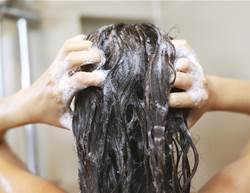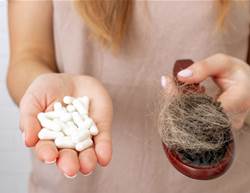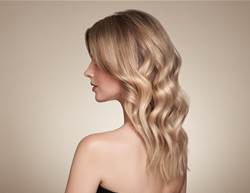Thanks to decades of testing all types of haircare, haircolour, styling products and tools as well as being immersed in the latest research, Good Housekeeping US' Beauty Lab experts have collected an arsenal of wisdom they use to keep their own hair looking (and feeling) its best. Read on for top tips for different hair types and concerns.
1. Conditioning boost
“Since my hair is textured and I both colour and heat-style it, regular conditioner doesn’t provide enough nourishment. Instead, I apply a hair mask in place of conditioner every time I shampoo, then follow that with a leave-in conditioner to layer in moisture.” —April Franzino, Good Housekeeping US beauty director.
2. Colour extender
"Though my grey roots become visible as early as three weeks after I colour my hair, I limit my salon visits to every four to five weeks to keep chemical hair damage to a minimum. To stretch the time between dyeing sessions, I apply a temporary root touch-up to blend my roots in along the part and my temples. I also wear my hair in its natural wavy texture instead of blowdrying it straight, which can make regrowth more noticeable.” —Birnur Aral, Good Housekeeping US beauty Lab executive director.
3. Hot tip
To avoid excess heat damage and potential burns, hold your hairdryer at least five inches (12cm) from your head when blowdrying.” —Sabina Wizemann, Good Housekeeping US beauty Lab senior chemist.
4. Frizz fixer
“To smooth flyaways around my hairline, I spray a little hairspray on an unused toothbrush and gently glide it over the hairs.” —Dori Price, Good Housekeeping US contributing beauty editor.
5. Oil reducer
“I try to avoid touching my hair during the day. It’s tempting to run my fingers through it, but since I have oily hair, transferring moisturisers and natural oils from my skin onto my strands only makes it worse. When I keep my hands off it, my hair is significantly less greasy, and the style lasts longer too.” —Catharine Malzahn, Good Housekeeping US beauty assistant.
6. More volume
“If you have fine or thin hair, spritz a volumising spray all over damp strands before styling. It instantly makes hair look and feel thicker without adding stickiness or weight.” —April Franzino.
7. Smart dye prep
“Don’t wash your hair right before you dye it. I try to skip shampooing on the day of and even the day before my trip to the salon. The natural oils on the scalp help prevent any sensitivity that the colour ingredients may cause.” —Birnur Aral.
8. Healthy scalp
"‘Shampoo’ isn’t a dirty word: 'No shampoo’ trends come and go, but there’s nothing wrong with a good cleanse. Regularly washing away oil buildup helps prevent scalp irritation due to oxidised sebum.” —Chiara Butler, Beauty Lab reviews analyst.
9. Before-bed head saver
“Never go to bed with your hair wet. Instead, allow hair to air-dry about 50% to 75% of the way, then use a hairdryer brush to align strands and lock them into place before going to sleep. This has saved me so much time on trying to repair bed head in the morning.” —Danusia Wnek, Beauty Lab senior chemist.
10. Fast dry
"Dry your hair with a microfibre towel. Switching to one of these has been a game changer for me—my hair dries faster and has noticeably less frizz and static since I ditched my cotton towel.” —Catharine Malzahn
“Air-dry or towel-dry hair before blowdrying. Unless I’m in a rush, I put my wet strands in a hair towel or let them air-dry until they feel damp. This cuts my blowdrying time to about a quarter of what it would be if I started with soaking-wet hair. It also exposes strands to less heat and brushing, which helps minimise thermal and mechanical damage.” —Birnur Aral
11. Accessory swap
“Opt for scrunchies rather than traditional hair ties. Once I swapped my hair elastics for scrunchies, I never looked back—they feel much gentler on my hair and cause less friction, tangling and breakage.” —Chiara Butler
12. Quick hair fix
“I keep a styling cream handy at home and on my desk at work for touch-ups. I rub a small dab between my fingers, then glide them over my hair to smooth, soften and reshape strands and frayed ends when needed.” —April Franzino
13. Gentle wash
“When washing hair, instead of rubbing shampoo into your scalp with your nails, apply it close to the roots, and massage it in gently with your fingertips and palms, then work it through your hair. Using your nails can scratch or irritate scalp skin.” —Sabina Wizemann
14. Wet-hair care
“Always use a comb or a brush designed for wet hair after you shower. Your hair is in its most delicate state when it’s wet, so it can break more easily if you don’t choose the right tools.” —Dori Price
15. Personalised products
“Just like with skincare, you can spot-treat with haircare products. If you have an oily scalp but your strands still need nourishment, try applying your conditioner or hair mask about two inches away from your scalp, or start from hair tips and work your way up strands. This will prevent the crown from getting weighed down.”—Danusia Wnek
16. Safer heat styling
“Never use a styling iron on wet (or even damp) hair: It can cause water trapped in the hair fibres to boil and rapidly expand, creating bubbles that lead to breakage. Be sure to dry your hair completely before beginning to style.” —Chiara Butler










